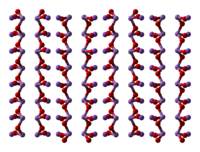
Does the dose make the poison? Neurotoxic insecticides impair predator orientation and reproduction even at low concentrations
Sign Up to like & getrecommendations! Published in 2022 at "Pest Management Science"
DOI: 10.1002/ps.6789
Abstract: Abstract BACKGROUND Pesticides can be noxious to non‐target beneficial arthropods and their negative effects have been recently recognized even at low doses. The predator Nesidiocoris tenuis (Reuter) (Hemiptera: Miridae) plays an important role in controlling… read more here.
Keywords: lambda cyhalothrin; predator orientation; even low; predator ... See more keywords

Low concentrations of sodium arsenite induce hepatotoxicity in prepubertal male rats
Sign Up to like & getrecommendations! Published in 2019 at "Environmental Toxicology"
DOI: 10.1002/tox.22890
Abstract: Arsenic (As) can contaminate air, soil, water, and organisms through mobilization of natural mineralogical deposits or anthropogenic actions. Inorganic‐As compounds are more toxic and widely available in aquatic environments, including drinking water reservoir catchments. Since… read more here.
Keywords: concentrations sodium; water; sodium arsenite; arsenite induce ... See more keywords

Ethanolamines permeate slowly across human skin ex vivo, but cause severe skin irritation at low concentrations
Sign Up to like & getrecommendations! Published in 2019 at "Archives of Toxicology"
DOI: 10.1007/s00204-019-02542-2
Abstract: Skin exposures are common during cleaning activities, and may contribute to the overall body burden. Cleaning products may contain irritants such as monoethanolamine (MEA) and diethanol amine (DEA). The significance of the skin exposure route… read more here.
Keywords: cleaning products; mea; human skin; skin ... See more keywords

Acute and single repeated dose effects of low concentrations of chlorpyrifos, diuron, and their combination on chicken
Sign Up to like & getrecommendations! Published in 2018 at "Environmental Science and Pollution Research"
DOI: 10.1007/s11356-018-1313-y
Abstract: This study investigated the acute and single repeated dose effects of low concentrations of chlorpyrifos, diuron, and their mixture to chicken. The effects were determined as biological response (chicken behavior); physiological response (body weight, gaining… read more here.
Keywords: single repeated; acute single; repeated dose; low concentrations ... See more keywords

The modulatory role of low concentrations of bisphenol A on tamoxifen-induced proliferation and apoptosis in breast cancer cells
Sign Up to like & getrecommendations! Published in 2018 at "Environmental Science and Pollution Research"
DOI: 10.1007/s11356-018-3780-6
Abstract: Selective estrogen receptor modulators such as tamoxifen (TAM) significantly reduce the risks of developing estrogen receptor–positive (ER+) breast cancer. Low concentrations (nanomolar range) of bisphenol A (BPA) shows estrogenic effects and further promotes the proliferation… read more here.
Keywords: breast; proliferation; breast cancer; cancer cells ... See more keywords

Performance and degradation mechanism of a sequencing batch biofilm reactor combined with an electrochemical process for the removal of low concentrations of cefuroxime
Sign Up to like & getrecommendations! Published in 2017 at "Chemical Engineering Journal"
DOI: 10.1016/j.cej.2017.03.037
Abstract: Abstract A combination of biochemistry and electrochemistry was used as a strategy to remove antibiotics present in low concentrations at the laboratory scale. Experiments showed that the removal of antibiotics could be improved to 98%… read more here.
Keywords: biochemistry; degradation; process; low concentrations ... See more keywords

Mechanism of low concentrations of polystyrene microplastics influence the cytotoxicity of Ag ions to Escherichia coli.
Sign Up to like & getrecommendations! Published in 2020 at "Chemosphere"
DOI: 10.1016/j.chemosphere.2020.126705
Abstract: Polystyrene microplastics (PSMPs) with different sizes, surface charges and aging statuses simulated field PSMPs and were applied to understand their cytotoxicity to Escherichia coli. The PSMPs hardly affected the viability, membrane integrity, ROS generation and… read more here.
Keywords: polystyrene microplastics; escherichia coli; field psmps; low concentrations ... See more keywords

Removal of low concentrations of nickel ions in electroplating wastewater using capacitive deionization technology.
Sign Up to like & getrecommendations! Published in 2021 at "Chemosphere"
DOI: 10.1016/j.chemosphere.2021.131341
Abstract: The capacitive deionization (CDI) technology was adopted to reduce the low concentrations of nickel in electroplating wastewater to meet the discharge standard. The composite anode and the composite cathode (Resin-CGA) were prepared by incorporating anion-exchange… read more here.
Keywords: electroplating wastewater; wastewater; resin cga; low concentrations ... See more keywords

The effect of arsenite on spatial learning: Involvement of autophagy and apoptosis
Sign Up to like & getrecommendations! Published in 2017 at "European Journal of Pharmacology"
DOI: 10.1016/j.ejphar.2016.12.023
Abstract: ABSTRACT Spatial learning plays a major role in one's information recording. Arsenic is one of ubiquitous environmental toxins with known neurological effects. However, studies investigating the effects of arsenic on spatial learning and related mechanisms… read more here.
Keywords: spatial learning; apoptosis; concentrations sodium; sodium arsenite ... See more keywords

Synergistic Effects of Sodium Iodide and Sodium Dodecyl Sulfate at Low Concentrations on Promoting Gas Hydrate Nucleation
Sign Up to like & getrecommendations! Published in 2020 at "Energy & Fuels"
DOI: 10.1021/acs.energyfuels.0c01725
Abstract: Surfactants and/or salts at low concentrations are inherently relevant to gas hydrate formation in nature and industry. However, the combined effects of surfactants and salts at low concentrations ... read more here.
Keywords: effects sodium; gas hydrate; low concentrations; synergistic effects ... See more keywords

Hormetic Promotion of Biofilm Growth by Polyvalent Bacteriophages at Low Concentrations.
Sign Up to like & getrecommendations! Published in 2020 at "Environmental science & technology"
DOI: 10.1021/acs.est.0c03558
Abstract: Interactions between bacteriophages (phages) and biofilms are poorly understood despite their broad ecological and water quality implications. Here, we report that biofilm exposure to lytic polyvalent phages at low concentrations (i.e., 102 - 104 phages/mL)… read more here.
Keywords: polyvalent; biofilm growth; biofilm; unexposed controls ... See more keywords